Reflection of Teaching Experiences Report - Higher Education
VerifiedAdded on 2023/06/07
|10
|2847
|120
Report
AI Summary
This report presents a comprehensive reflection on a teaching experience, likely for a higher education assignment. The student details the importance of teaching plans, emphasizing their role in guiding lecture delivery and student learning. The report then delves into the epidemiological rationale for the chosen topic, highlighting the need for clear and concise information delivery. Self-evaluation is discussed, stressing its significance in assessing teaching effectiveness through methods like self-monitoring and student feedback. The role of community response to teaching is explored, underscoring the importance of community involvement in supporting education. The report concludes by identifying areas of strength, such as communication skills, and areas for improvement, such as incorporating new teaching strategies and technologies. The student emphasizes the need for continuous professional development and adaptation to meet student needs. Finally, the report reflects on the importance of education in addressing unemployment and fostering a knowledgeable populace.
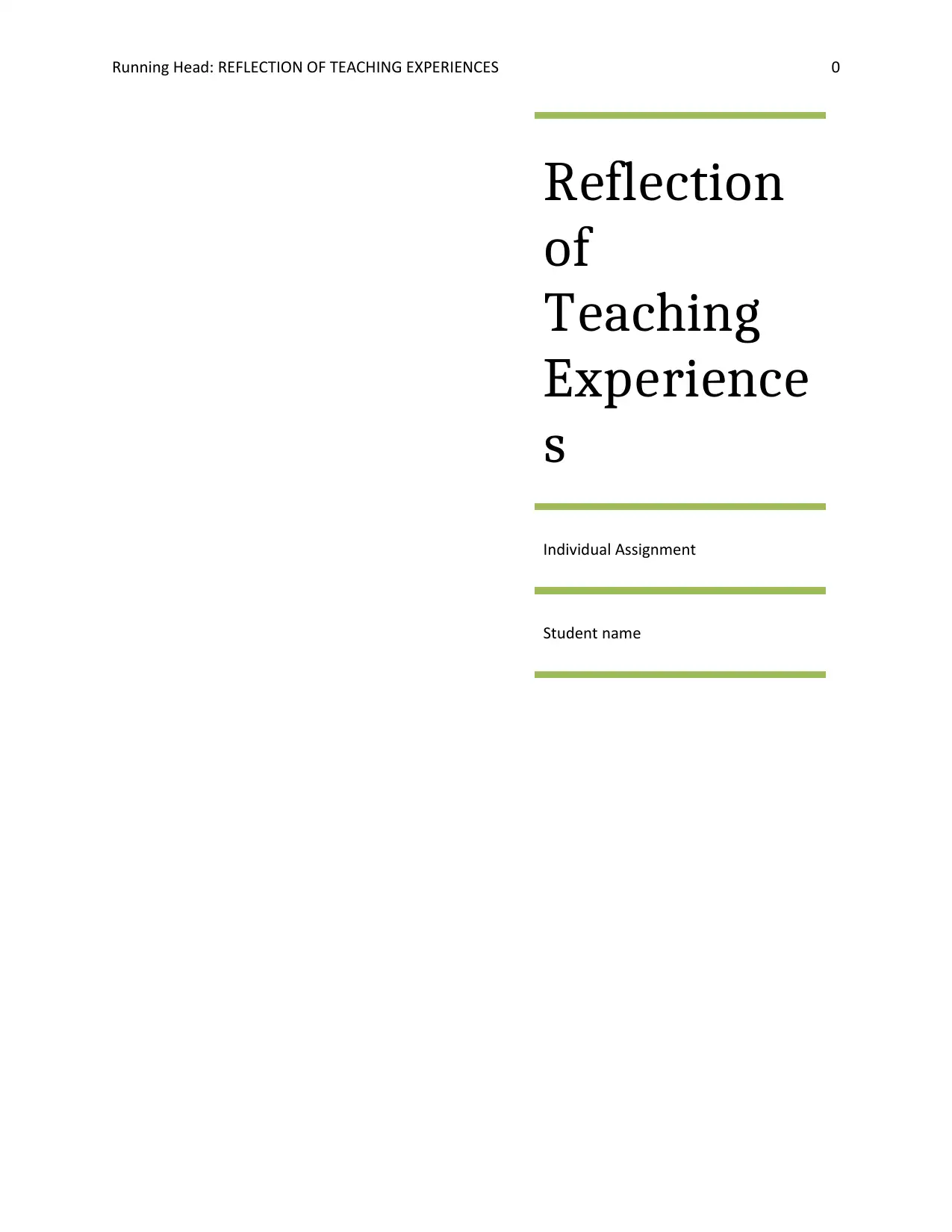
Running Head: REFLECTION OF TEACHING EXPERIENCES 0
Reflection
of
Teaching
Experience
s
Individual Assignment
Student name
Reflection
of
Teaching
Experience
s
Individual Assignment
Student name
Paraphrase This Document
Need a fresh take? Get an instant paraphrase of this document with our AI Paraphraser
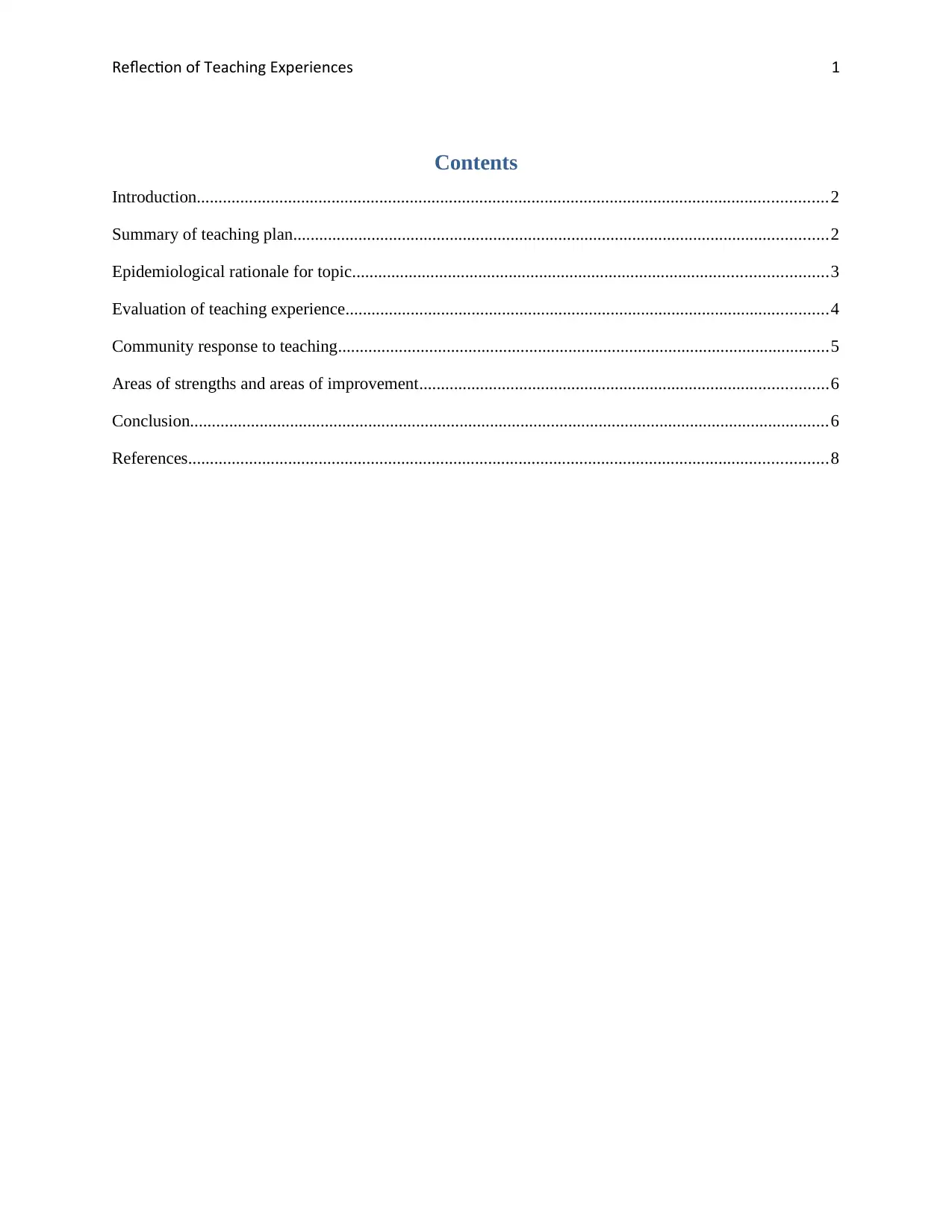
Reflection of Teaching Experiences 1
Contents
Introduction.................................................................................................................................................2
Summary of teaching plan...........................................................................................................................2
Epidemiological rationale for topic.............................................................................................................3
Evaluation of teaching experience...............................................................................................................4
Community response to teaching.................................................................................................................5
Areas of strengths and areas of improvement..............................................................................................6
Conclusion...................................................................................................................................................6
References...................................................................................................................................................8
Contents
Introduction.................................................................................................................................................2
Summary of teaching plan...........................................................................................................................2
Epidemiological rationale for topic.............................................................................................................3
Evaluation of teaching experience...............................................................................................................4
Community response to teaching.................................................................................................................5
Areas of strengths and areas of improvement..............................................................................................6
Conclusion...................................................................................................................................................6
References...................................................................................................................................................8
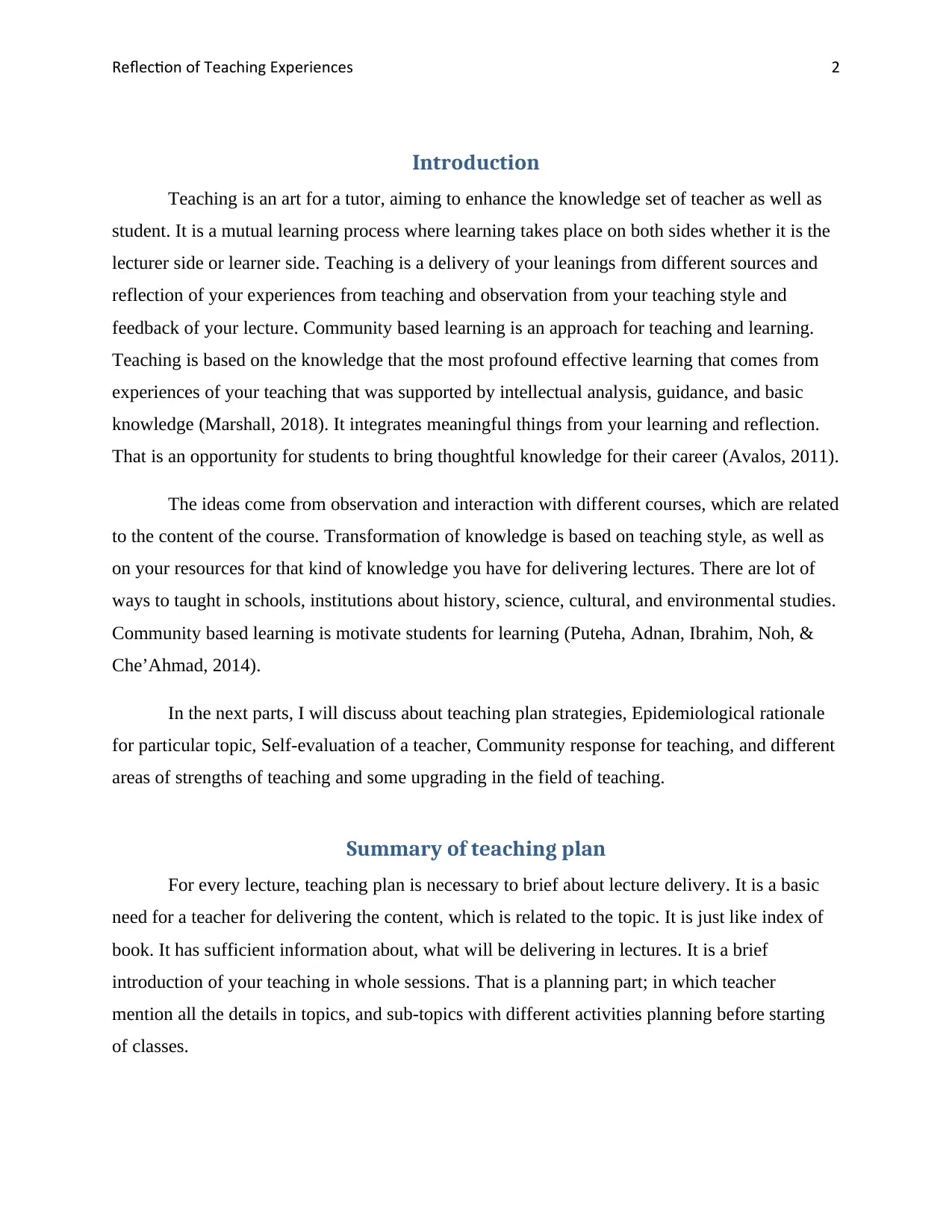
Reflection of Teaching Experiences 2
Introduction
Teaching is an art for a tutor, aiming to enhance the knowledge set of teacher as well as
student. It is a mutual learning process where learning takes place on both sides whether it is the
lecturer side or learner side. Teaching is a delivery of your leanings from different sources and
reflection of your experiences from teaching and observation from your teaching style and
feedback of your lecture. Community based learning is an approach for teaching and learning.
Teaching is based on the knowledge that the most profound effective learning that comes from
experiences of your teaching that was supported by intellectual analysis, guidance, and basic
knowledge (Marshall, 2018). It integrates meaningful things from your learning and reflection.
That is an opportunity for students to bring thoughtful knowledge for their career (Avalos, 2011).
The ideas come from observation and interaction with different courses, which are related
to the content of the course. Transformation of knowledge is based on teaching style, as well as
on your resources for that kind of knowledge you have for delivering lectures. There are lot of
ways to taught in schools, institutions about history, science, cultural, and environmental studies.
Community based learning is motivate students for learning (Puteha, Adnan, Ibrahim, Noh, &
Che’Ahmad, 2014).
In the next parts, I will discuss about teaching plan strategies, Epidemiological rationale
for particular topic, Self-evaluation of a teacher, Community response for teaching, and different
areas of strengths of teaching and some upgrading in the field of teaching.
Summary of teaching plan
For every lecture, teaching plan is necessary to brief about lecture delivery. It is a basic
need for a teacher for delivering the content, which is related to the topic. It is just like index of
book. It has sufficient information about, what will be delivering in lectures. It is a brief
introduction of your teaching in whole sessions. That is a planning part; in which teacher
mention all the details in topics, and sub-topics with different activities planning before starting
of classes.
Introduction
Teaching is an art for a tutor, aiming to enhance the knowledge set of teacher as well as
student. It is a mutual learning process where learning takes place on both sides whether it is the
lecturer side or learner side. Teaching is a delivery of your leanings from different sources and
reflection of your experiences from teaching and observation from your teaching style and
feedback of your lecture. Community based learning is an approach for teaching and learning.
Teaching is based on the knowledge that the most profound effective learning that comes from
experiences of your teaching that was supported by intellectual analysis, guidance, and basic
knowledge (Marshall, 2018). It integrates meaningful things from your learning and reflection.
That is an opportunity for students to bring thoughtful knowledge for their career (Avalos, 2011).
The ideas come from observation and interaction with different courses, which are related
to the content of the course. Transformation of knowledge is based on teaching style, as well as
on your resources for that kind of knowledge you have for delivering lectures. There are lot of
ways to taught in schools, institutions about history, science, cultural, and environmental studies.
Community based learning is motivate students for learning (Puteha, Adnan, Ibrahim, Noh, &
Che’Ahmad, 2014).
In the next parts, I will discuss about teaching plan strategies, Epidemiological rationale
for particular topic, Self-evaluation of a teacher, Community response for teaching, and different
areas of strengths of teaching and some upgrading in the field of teaching.
Summary of teaching plan
For every lecture, teaching plan is necessary to brief about lecture delivery. It is a basic
need for a teacher for delivering the content, which is related to the topic. It is just like index of
book. It has sufficient information about, what will be delivering in lectures. It is a brief
introduction of your teaching in whole sessions. That is a planning part; in which teacher
mention all the details in topics, and sub-topics with different activities planning before starting
of classes.
⊘ This is a preview!⊘
Do you want full access?
Subscribe today to unlock all pages.

Trusted by 1+ million students worldwide
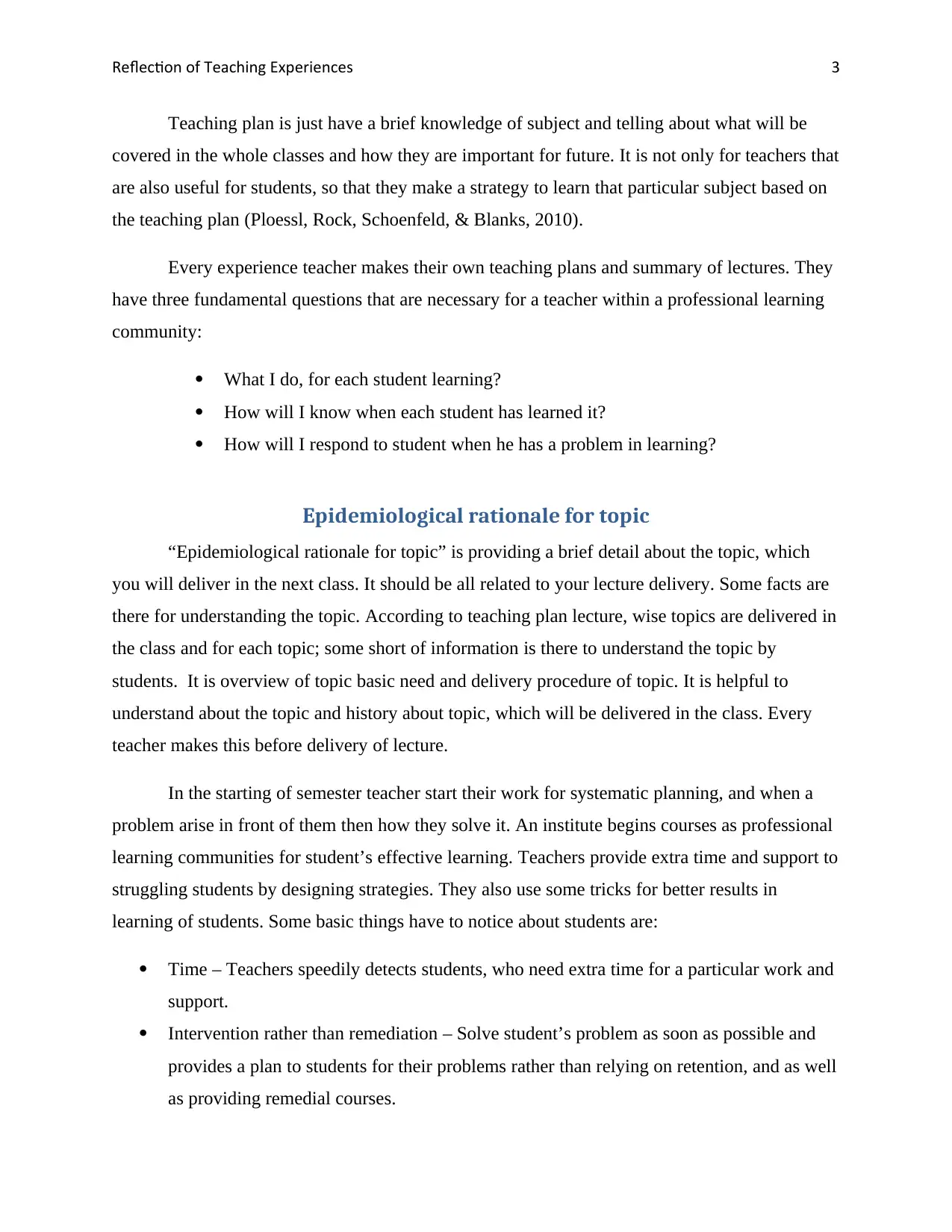
Reflection of Teaching Experiences 3
Teaching plan is just have a brief knowledge of subject and telling about what will be
covered in the whole classes and how they are important for future. It is not only for teachers that
are also useful for students, so that they make a strategy to learn that particular subject based on
the teaching plan (Ploessl, Rock, Schoenfeld, & Blanks, 2010).
Every experience teacher makes their own teaching plans and summary of lectures. They
have three fundamental questions that are necessary for a teacher within a professional learning
community:
What I do, for each student learning?
How will I know when each student has learned it?
How will I respond to student when he has a problem in learning?
Epidemiological rationale for topic
“Epidemiological rationale for topic” is providing a brief detail about the topic, which
you will deliver in the next class. It should be all related to your lecture delivery. Some facts are
there for understanding the topic. According to teaching plan lecture, wise topics are delivered in
the class and for each topic; some short of information is there to understand the topic by
students. It is overview of topic basic need and delivery procedure of topic. It is helpful to
understand about the topic and history about topic, which will be delivered in the class. Every
teacher makes this before delivery of lecture.
In the starting of semester teacher start their work for systematic planning, and when a
problem arise in front of them then how they solve it. An institute begins courses as professional
learning communities for student’s effective learning. Teachers provide extra time and support to
struggling students by designing strategies. They also use some tricks for better results in
learning of students. Some basic things have to notice about students are:
Time – Teachers speedily detects students, who need extra time for a particular work and
support.
Intervention rather than remediation – Solve student’s problem as soon as possible and
provides a plan to students for their problems rather than relying on retention, and as well
as providing remedial courses.
Teaching plan is just have a brief knowledge of subject and telling about what will be
covered in the whole classes and how they are important for future. It is not only for teachers that
are also useful for students, so that they make a strategy to learn that particular subject based on
the teaching plan (Ploessl, Rock, Schoenfeld, & Blanks, 2010).
Every experience teacher makes their own teaching plans and summary of lectures. They
have three fundamental questions that are necessary for a teacher within a professional learning
community:
What I do, for each student learning?
How will I know when each student has learned it?
How will I respond to student when he has a problem in learning?
Epidemiological rationale for topic
“Epidemiological rationale for topic” is providing a brief detail about the topic, which
you will deliver in the next class. It should be all related to your lecture delivery. Some facts are
there for understanding the topic. According to teaching plan lecture, wise topics are delivered in
the class and for each topic; some short of information is there to understand the topic by
students. It is overview of topic basic need and delivery procedure of topic. It is helpful to
understand about the topic and history about topic, which will be delivered in the class. Every
teacher makes this before delivery of lecture.
In the starting of semester teacher start their work for systematic planning, and when a
problem arise in front of them then how they solve it. An institute begins courses as professional
learning communities for student’s effective learning. Teachers provide extra time and support to
struggling students by designing strategies. They also use some tricks for better results in
learning of students. Some basic things have to notice about students are:
Time – Teachers speedily detects students, who need extra time for a particular work and
support.
Intervention rather than remediation – Solve student’s problem as soon as possible and
provides a plan to students for their problems rather than relying on retention, and as well
as providing remedial courses.
Paraphrase This Document
Need a fresh take? Get an instant paraphrase of this document with our AI Paraphraser
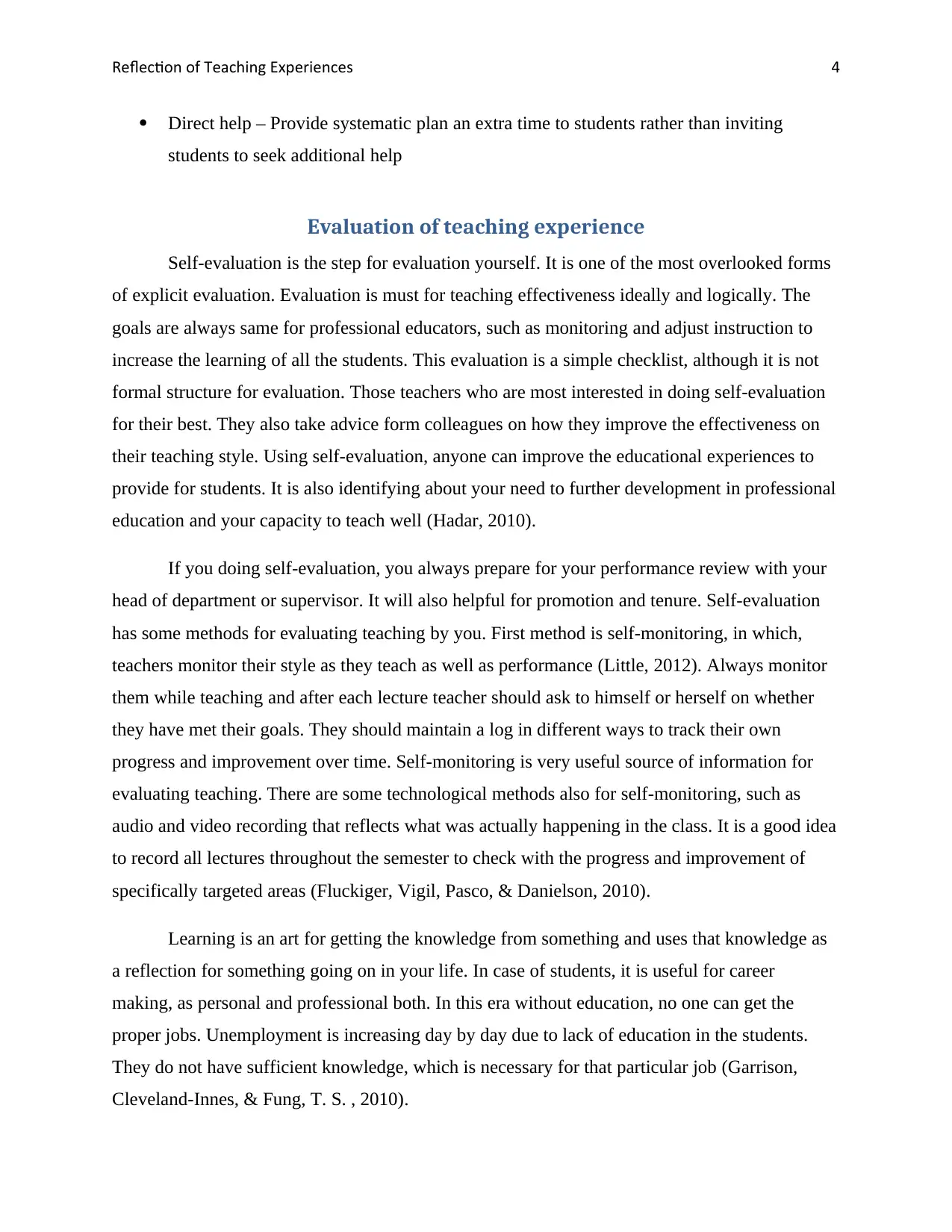
Reflection of Teaching Experiences 4
Direct help – Provide systematic plan an extra time to students rather than inviting
students to seek additional help
Evaluation of teaching experience
Self-evaluation is the step for evaluation yourself. It is one of the most overlooked forms
of explicit evaluation. Evaluation is must for teaching effectiveness ideally and logically. The
goals are always same for professional educators, such as monitoring and adjust instruction to
increase the learning of all the students. This evaluation is a simple checklist, although it is not
formal structure for evaluation. Those teachers who are most interested in doing self-evaluation
for their best. They also take advice form colleagues on how they improve the effectiveness on
their teaching style. Using self-evaluation, anyone can improve the educational experiences to
provide for students. It is also identifying about your need to further development in professional
education and your capacity to teach well (Hadar, 2010).
If you doing self-evaluation, you always prepare for your performance review with your
head of department or supervisor. It will also helpful for promotion and tenure. Self-evaluation
has some methods for evaluating teaching by you. First method is self-monitoring, in which,
teachers monitor their style as they teach as well as performance (Little, 2012). Always monitor
them while teaching and after each lecture teacher should ask to himself or herself on whether
they have met their goals. They should maintain a log in different ways to track their own
progress and improvement over time. Self-monitoring is very useful source of information for
evaluating teaching. There are some technological methods also for self-monitoring, such as
audio and video recording that reflects what was actually happening in the class. It is a good idea
to record all lectures throughout the semester to check with the progress and improvement of
specifically targeted areas (Fluckiger, Vigil, Pasco, & Danielson, 2010).
Learning is an art for getting the knowledge from something and uses that knowledge as
a reflection for something going on in your life. In case of students, it is useful for career
making, as personal and professional both. In this era without education, no one can get the
proper jobs. Unemployment is increasing day by day due to lack of education in the students.
They do not have sufficient knowledge, which is necessary for that particular job (Garrison,
Cleveland-Innes, & Fung, T. S. , 2010).
Direct help – Provide systematic plan an extra time to students rather than inviting
students to seek additional help
Evaluation of teaching experience
Self-evaluation is the step for evaluation yourself. It is one of the most overlooked forms
of explicit evaluation. Evaluation is must for teaching effectiveness ideally and logically. The
goals are always same for professional educators, such as monitoring and adjust instruction to
increase the learning of all the students. This evaluation is a simple checklist, although it is not
formal structure for evaluation. Those teachers who are most interested in doing self-evaluation
for their best. They also take advice form colleagues on how they improve the effectiveness on
their teaching style. Using self-evaluation, anyone can improve the educational experiences to
provide for students. It is also identifying about your need to further development in professional
education and your capacity to teach well (Hadar, 2010).
If you doing self-evaluation, you always prepare for your performance review with your
head of department or supervisor. It will also helpful for promotion and tenure. Self-evaluation
has some methods for evaluating teaching by you. First method is self-monitoring, in which,
teachers monitor their style as they teach as well as performance (Little, 2012). Always monitor
them while teaching and after each lecture teacher should ask to himself or herself on whether
they have met their goals. They should maintain a log in different ways to track their own
progress and improvement over time. Self-monitoring is very useful source of information for
evaluating teaching. There are some technological methods also for self-monitoring, such as
audio and video recording that reflects what was actually happening in the class. It is a good idea
to record all lectures throughout the semester to check with the progress and improvement of
specifically targeted areas (Fluckiger, Vigil, Pasco, & Danielson, 2010).
Learning is an art for getting the knowledge from something and uses that knowledge as
a reflection for something going on in your life. In case of students, it is useful for career
making, as personal and professional both. In this era without education, no one can get the
proper jobs. Unemployment is increasing day by day due to lack of education in the students.
They do not have sufficient knowledge, which is necessary for that particular job (Garrison,
Cleveland-Innes, & Fung, T. S. , 2010).
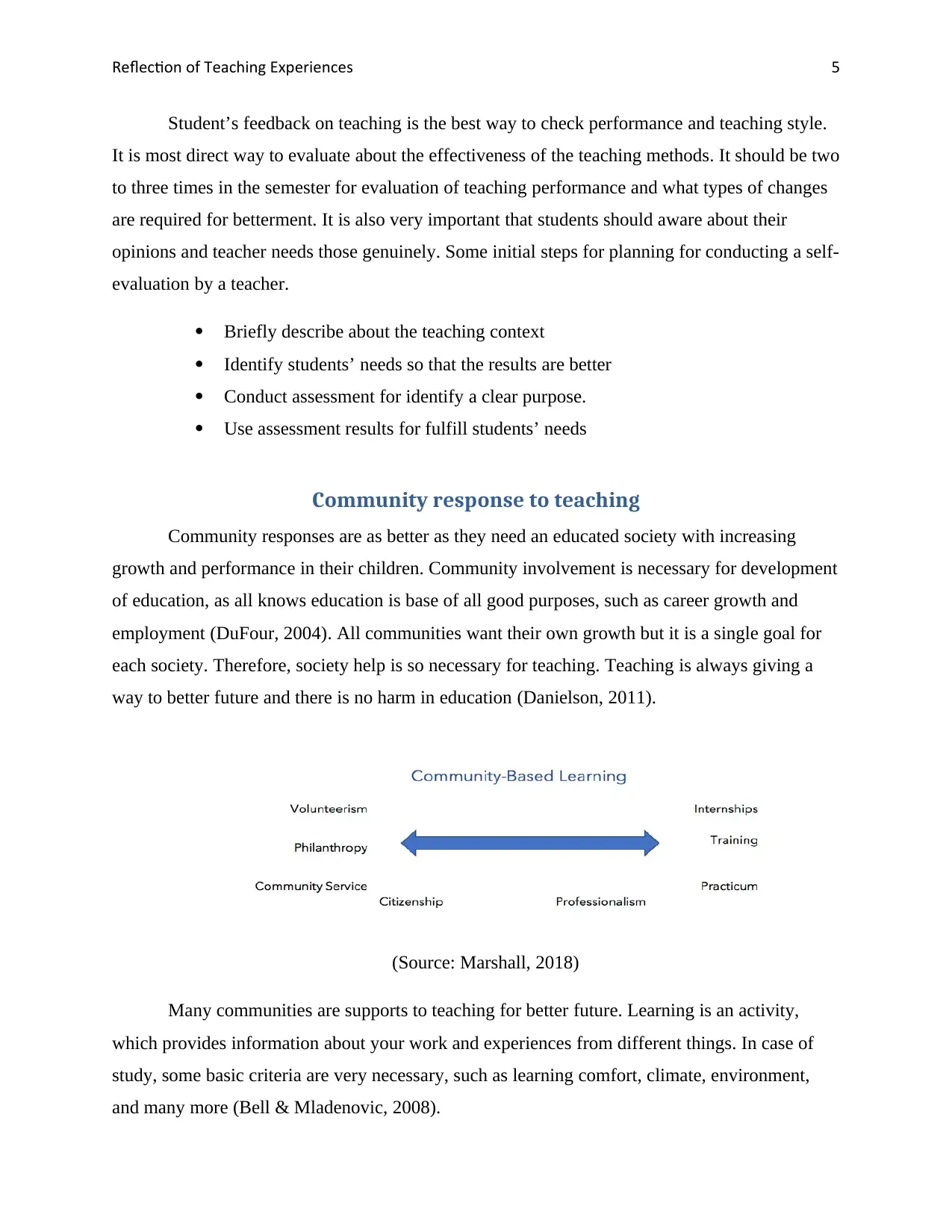
Reflection of Teaching Experiences 5
Student’s feedback on teaching is the best way to check performance and teaching style.
It is most direct way to evaluate about the effectiveness of the teaching methods. It should be two
to three times in the semester for evaluation of teaching performance and what types of changes
are required for betterment. It is also very important that students should aware about their
opinions and teacher needs those genuinely. Some initial steps for planning for conducting a self-
evaluation by a teacher.
Briefly describe about the teaching context
Identify students’ needs so that the results are better
Conduct assessment for identify a clear purpose.
Use assessment results for fulfill students’ needs
Community response to teaching
Community responses are as better as they need an educated society with increasing
growth and performance in their children. Community involvement is necessary for development
of education, as all knows education is base of all good purposes, such as career growth and
employment (DuFour, 2004). All communities want their own growth but it is a single goal for
each society. Therefore, society help is so necessary for teaching. Teaching is always giving a
way to better future and there is no harm in education (Danielson, 2011).
(Source: Marshall, 2018)
Many communities are supports to teaching for better future. Learning is an activity,
which provides information about your work and experiences from different things. In case of
study, some basic criteria are very necessary, such as learning comfort, climate, environment,
and many more (Bell & Mladenovic, 2008).
Student’s feedback on teaching is the best way to check performance and teaching style.
It is most direct way to evaluate about the effectiveness of the teaching methods. It should be two
to three times in the semester for evaluation of teaching performance and what types of changes
are required for betterment. It is also very important that students should aware about their
opinions and teacher needs those genuinely. Some initial steps for planning for conducting a self-
evaluation by a teacher.
Briefly describe about the teaching context
Identify students’ needs so that the results are better
Conduct assessment for identify a clear purpose.
Use assessment results for fulfill students’ needs
Community response to teaching
Community responses are as better as they need an educated society with increasing
growth and performance in their children. Community involvement is necessary for development
of education, as all knows education is base of all good purposes, such as career growth and
employment (DuFour, 2004). All communities want their own growth but it is a single goal for
each society. Therefore, society help is so necessary for teaching. Teaching is always giving a
way to better future and there is no harm in education (Danielson, 2011).
(Source: Marshall, 2018)
Many communities are supports to teaching for better future. Learning is an activity,
which provides information about your work and experiences from different things. In case of
study, some basic criteria are very necessary, such as learning comfort, climate, environment,
and many more (Bell & Mladenovic, 2008).
⊘ This is a preview!⊘
Do you want full access?
Subscribe today to unlock all pages.

Trusted by 1+ million students worldwide
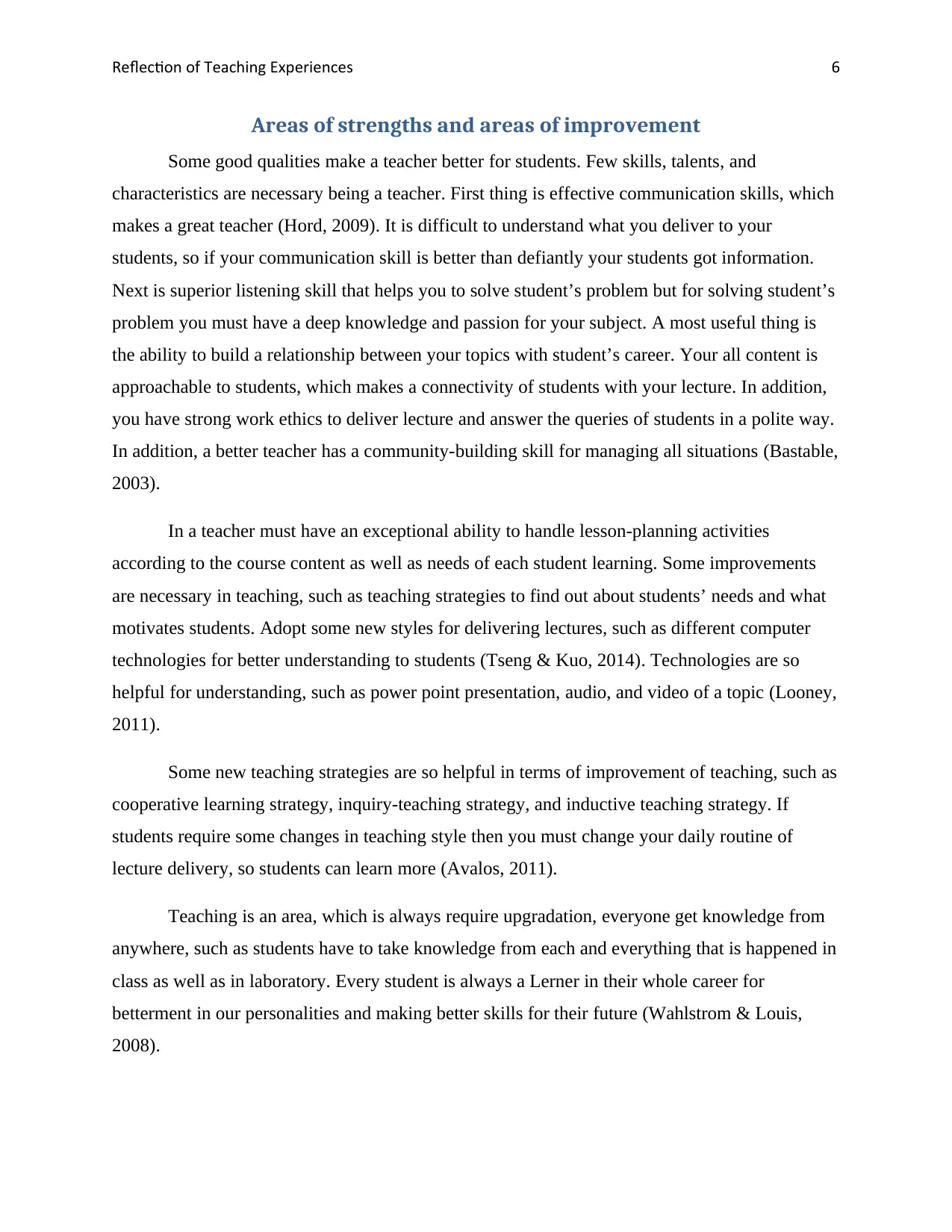
Reflection of Teaching Experiences 6
Areas of strengths and areas of improvement
Some good qualities make a teacher better for students. Few skills, talents, and
characteristics are necessary being a teacher. First thing is effective communication skills, which
makes a great teacher (Hord, 2009). It is difficult to understand what you deliver to your
students, so if your communication skill is better than defiantly your students got information.
Next is superior listening skill that helps you to solve student’s problem but for solving student’s
problem you must have a deep knowledge and passion for your subject. A most useful thing is
the ability to build a relationship between your topics with student’s career. Your all content is
approachable to students, which makes a connectivity of students with your lecture. In addition,
you have strong work ethics to deliver lecture and answer the queries of students in a polite way.
In addition, a better teacher has a community-building skill for managing all situations (Bastable,
2003).
In a teacher must have an exceptional ability to handle lesson-planning activities
according to the course content as well as needs of each student learning. Some improvements
are necessary in teaching, such as teaching strategies to find out about students’ needs and what
motivates students. Adopt some new styles for delivering lectures, such as different computer
technologies for better understanding to students (Tseng & Kuo, 2014). Technologies are so
helpful for understanding, such as power point presentation, audio, and video of a topic (Looney,
2011).
Some new teaching strategies are so helpful in terms of improvement of teaching, such as
cooperative learning strategy, inquiry-teaching strategy, and inductive teaching strategy. If
students require some changes in teaching style then you must change your daily routine of
lecture delivery, so students can learn more (Avalos, 2011).
Teaching is an area, which is always require upgradation, everyone get knowledge from
anywhere, such as students have to take knowledge from each and everything that is happened in
class as well as in laboratory. Every student is always a Lerner in their whole career for
betterment in our personalities and making better skills for their future (Wahlstrom & Louis,
2008).
Areas of strengths and areas of improvement
Some good qualities make a teacher better for students. Few skills, talents, and
characteristics are necessary being a teacher. First thing is effective communication skills, which
makes a great teacher (Hord, 2009). It is difficult to understand what you deliver to your
students, so if your communication skill is better than defiantly your students got information.
Next is superior listening skill that helps you to solve student’s problem but for solving student’s
problem you must have a deep knowledge and passion for your subject. A most useful thing is
the ability to build a relationship between your topics with student’s career. Your all content is
approachable to students, which makes a connectivity of students with your lecture. In addition,
you have strong work ethics to deliver lecture and answer the queries of students in a polite way.
In addition, a better teacher has a community-building skill for managing all situations (Bastable,
2003).
In a teacher must have an exceptional ability to handle lesson-planning activities
according to the course content as well as needs of each student learning. Some improvements
are necessary in teaching, such as teaching strategies to find out about students’ needs and what
motivates students. Adopt some new styles for delivering lectures, such as different computer
technologies for better understanding to students (Tseng & Kuo, 2014). Technologies are so
helpful for understanding, such as power point presentation, audio, and video of a topic (Looney,
2011).
Some new teaching strategies are so helpful in terms of improvement of teaching, such as
cooperative learning strategy, inquiry-teaching strategy, and inductive teaching strategy. If
students require some changes in teaching style then you must change your daily routine of
lecture delivery, so students can learn more (Avalos, 2011).
Teaching is an area, which is always require upgradation, everyone get knowledge from
anywhere, such as students have to take knowledge from each and everything that is happened in
class as well as in laboratory. Every student is always a Lerner in their whole career for
betterment in our personalities and making better skills for their future (Wahlstrom & Louis,
2008).
Paraphrase This Document
Need a fresh take? Get an instant paraphrase of this document with our AI Paraphraser
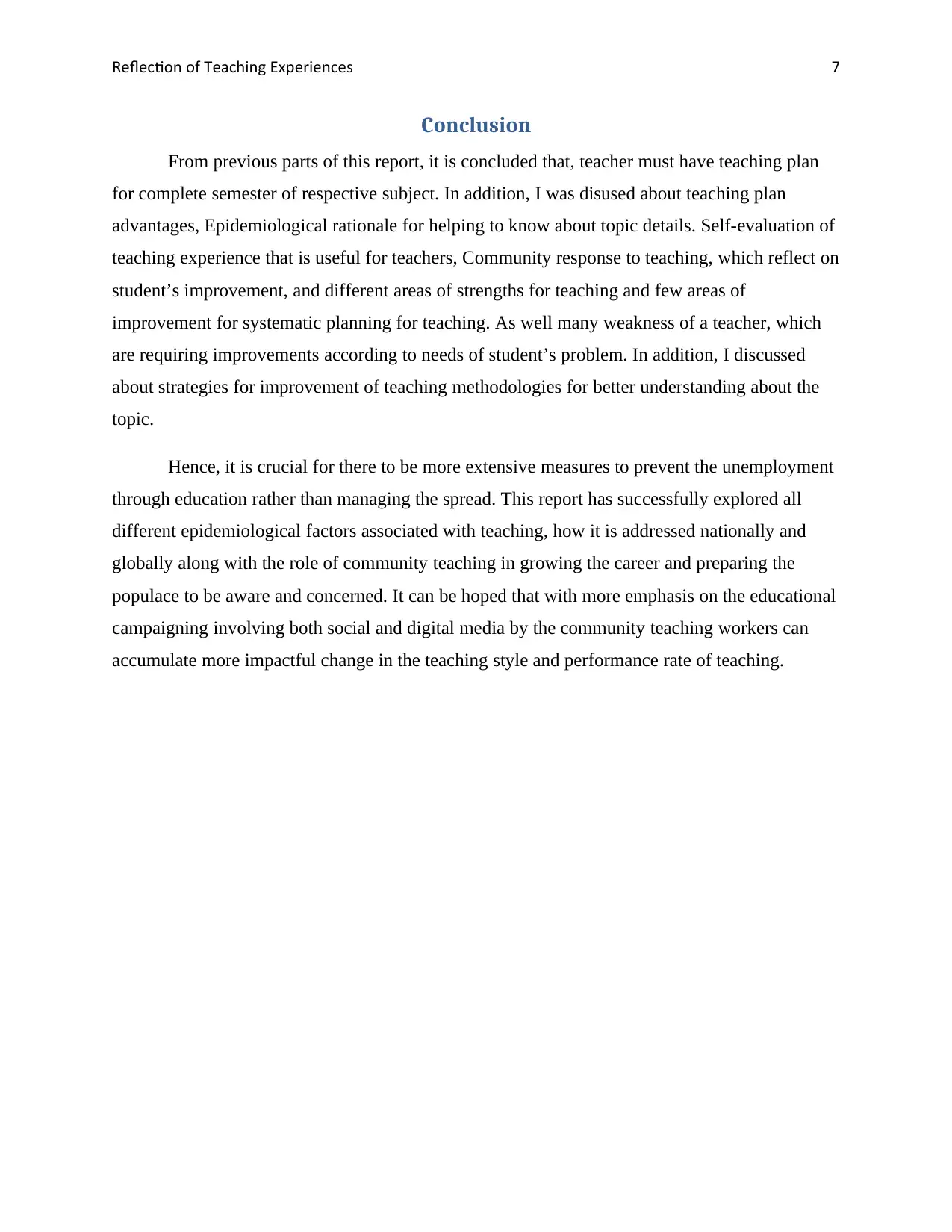
Reflection of Teaching Experiences 7
Conclusion
From previous parts of this report, it is concluded that, teacher must have teaching plan
for complete semester of respective subject. In addition, I was disused about teaching plan
advantages, Epidemiological rationale for helping to know about topic details. Self-evaluation of
teaching experience that is useful for teachers, Community response to teaching, which reflect on
student’s improvement, and different areas of strengths for teaching and few areas of
improvement for systematic planning for teaching. As well many weakness of a teacher, which
are requiring improvements according to needs of student’s problem. In addition, I discussed
about strategies for improvement of teaching methodologies for better understanding about the
topic.
Hence, it is crucial for there to be more extensive measures to prevent the unemployment
through education rather than managing the spread. This report has successfully explored all
different epidemiological factors associated with teaching, how it is addressed nationally and
globally along with the role of community teaching in growing the career and preparing the
populace to be aware and concerned. It can be hoped that with more emphasis on the educational
campaigning involving both social and digital media by the community teaching workers can
accumulate more impactful change in the teaching style and performance rate of teaching.
Conclusion
From previous parts of this report, it is concluded that, teacher must have teaching plan
for complete semester of respective subject. In addition, I was disused about teaching plan
advantages, Epidemiological rationale for helping to know about topic details. Self-evaluation of
teaching experience that is useful for teachers, Community response to teaching, which reflect on
student’s improvement, and different areas of strengths for teaching and few areas of
improvement for systematic planning for teaching. As well many weakness of a teacher, which
are requiring improvements according to needs of student’s problem. In addition, I discussed
about strategies for improvement of teaching methodologies for better understanding about the
topic.
Hence, it is crucial for there to be more extensive measures to prevent the unemployment
through education rather than managing the spread. This report has successfully explored all
different epidemiological factors associated with teaching, how it is addressed nationally and
globally along with the role of community teaching in growing the career and preparing the
populace to be aware and concerned. It can be hoped that with more emphasis on the educational
campaigning involving both social and digital media by the community teaching workers can
accumulate more impactful change in the teaching style and performance rate of teaching.
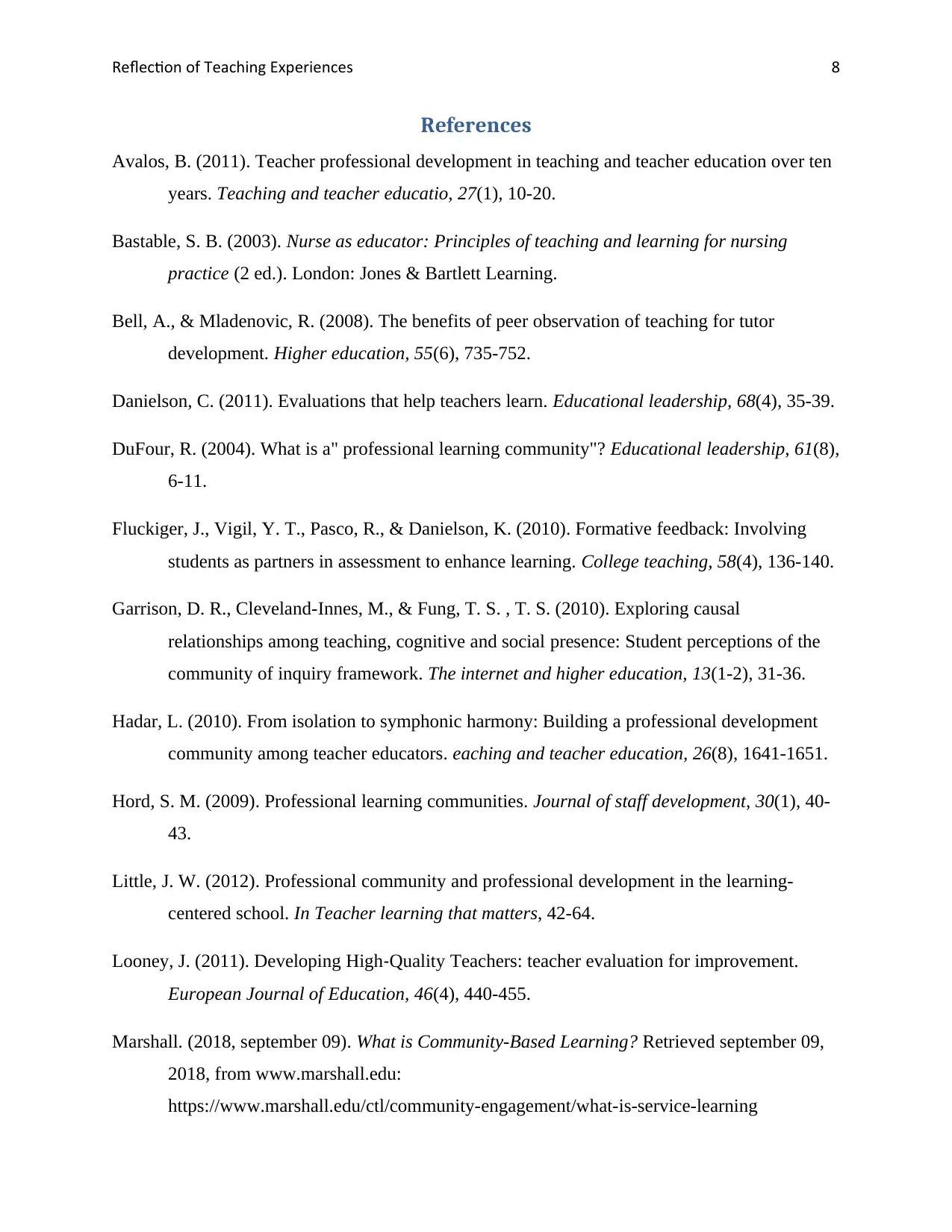
Reflection of Teaching Experiences 8
References
Avalos, B. (2011). Teacher professional development in teaching and teacher education over ten
years. Teaching and teacher educatio, 27(1), 10-20.
Bastable, S. B. (2003). Nurse as educator: Principles of teaching and learning for nursing
practice (2 ed.). London: Jones & Bartlett Learning.
Bell, A., & Mladenovic, R. (2008). The benefits of peer observation of teaching for tutor
development. Higher education, 55(6), 735-752.
Danielson, C. (2011). Evaluations that help teachers learn. Educational leadership, 68(4), 35-39.
DuFour, R. (2004). What is a" professional learning community"? Educational leadership, 61(8),
6-11.
Fluckiger, J., Vigil, Y. T., Pasco, R., & Danielson, K. (2010). Formative feedback: Involving
students as partners in assessment to enhance learning. College teaching, 58(4), 136-140.
Garrison, D. R., Cleveland-Innes, M., & Fung, T. S. , T. S. (2010). Exploring causal
relationships among teaching, cognitive and social presence: Student perceptions of the
community of inquiry framework. The internet and higher education, 13(1-2), 31-36.
Hadar, L. (2010). From isolation to symphonic harmony: Building a professional development
community among teacher educators. eaching and teacher education, 26(8), 1641-1651.
Hord, S. M. (2009). Professional learning communities. Journal of staff development, 30(1), 40-
43.
Little, J. W. (2012). Professional community and professional development in the learning-
centered school. In Teacher learning that matters, 42-64.
Looney, J. (2011). Developing High‐Quality Teachers: teacher evaluation for improvement.
European Journal of Education, 46(4), 440-455.
Marshall. (2018, september 09). What is Community-Based Learning? Retrieved september 09,
2018, from www.marshall.edu:
https://www.marshall.edu/ctl/community-engagement/what-is-service-learning
References
Avalos, B. (2011). Teacher professional development in teaching and teacher education over ten
years. Teaching and teacher educatio, 27(1), 10-20.
Bastable, S. B. (2003). Nurse as educator: Principles of teaching and learning for nursing
practice (2 ed.). London: Jones & Bartlett Learning.
Bell, A., & Mladenovic, R. (2008). The benefits of peer observation of teaching for tutor
development. Higher education, 55(6), 735-752.
Danielson, C. (2011). Evaluations that help teachers learn. Educational leadership, 68(4), 35-39.
DuFour, R. (2004). What is a" professional learning community"? Educational leadership, 61(8),
6-11.
Fluckiger, J., Vigil, Y. T., Pasco, R., & Danielson, K. (2010). Formative feedback: Involving
students as partners in assessment to enhance learning. College teaching, 58(4), 136-140.
Garrison, D. R., Cleveland-Innes, M., & Fung, T. S. , T. S. (2010). Exploring causal
relationships among teaching, cognitive and social presence: Student perceptions of the
community of inquiry framework. The internet and higher education, 13(1-2), 31-36.
Hadar, L. (2010). From isolation to symphonic harmony: Building a professional development
community among teacher educators. eaching and teacher education, 26(8), 1641-1651.
Hord, S. M. (2009). Professional learning communities. Journal of staff development, 30(1), 40-
43.
Little, J. W. (2012). Professional community and professional development in the learning-
centered school. In Teacher learning that matters, 42-64.
Looney, J. (2011). Developing High‐Quality Teachers: teacher evaluation for improvement.
European Journal of Education, 46(4), 440-455.
Marshall. (2018, september 09). What is Community-Based Learning? Retrieved september 09,
2018, from www.marshall.edu:
https://www.marshall.edu/ctl/community-engagement/what-is-service-learning
⊘ This is a preview!⊘
Do you want full access?
Subscribe today to unlock all pages.

Trusted by 1+ million students worldwide
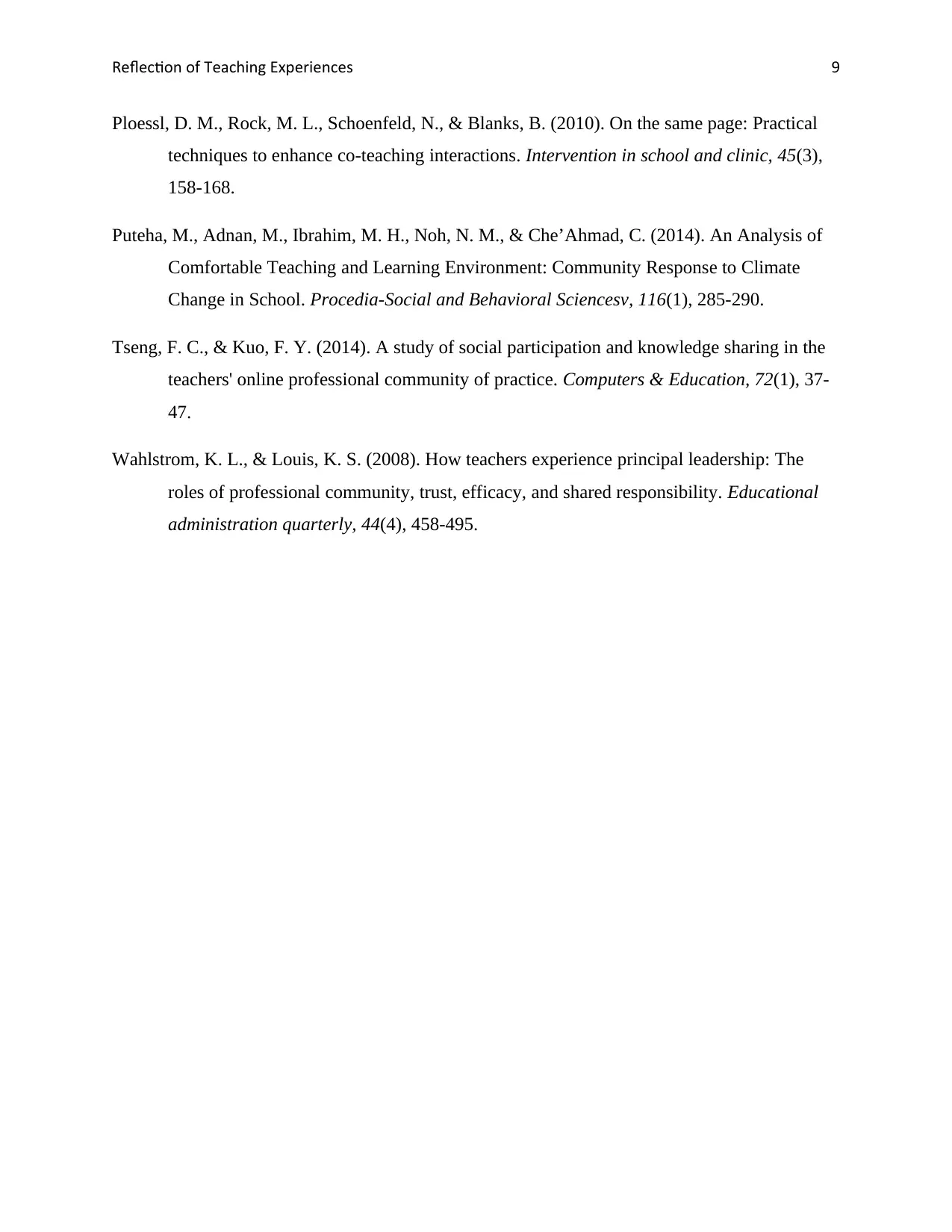
Reflection of Teaching Experiences 9
Ploessl, D. M., Rock, M. L., Schoenfeld, N., & Blanks, B. (2010). On the same page: Practical
techniques to enhance co-teaching interactions. Intervention in school and clinic, 45(3),
158-168.
Puteha, M., Adnan, M., Ibrahim, M. H., Noh, N. M., & Che’Ahmad, C. (2014). An Analysis of
Comfortable Teaching and Learning Environment: Community Response to Climate
Change in School. Procedia-Social and Behavioral Sciencesv, 116(1), 285-290.
Tseng, F. C., & Kuo, F. Y. (2014). A study of social participation and knowledge sharing in the
teachers' online professional community of practice. Computers & Education, 72(1), 37-
47.
Wahlstrom, K. L., & Louis, K. S. (2008). How teachers experience principal leadership: The
roles of professional community, trust, efficacy, and shared responsibility. Educational
administration quarterly, 44(4), 458-495.
Ploessl, D. M., Rock, M. L., Schoenfeld, N., & Blanks, B. (2010). On the same page: Practical
techniques to enhance co-teaching interactions. Intervention in school and clinic, 45(3),
158-168.
Puteha, M., Adnan, M., Ibrahim, M. H., Noh, N. M., & Che’Ahmad, C. (2014). An Analysis of
Comfortable Teaching and Learning Environment: Community Response to Climate
Change in School. Procedia-Social and Behavioral Sciencesv, 116(1), 285-290.
Tseng, F. C., & Kuo, F. Y. (2014). A study of social participation and knowledge sharing in the
teachers' online professional community of practice. Computers & Education, 72(1), 37-
47.
Wahlstrom, K. L., & Louis, K. S. (2008). How teachers experience principal leadership: The
roles of professional community, trust, efficacy, and shared responsibility. Educational
administration quarterly, 44(4), 458-495.
1 out of 10
Related Documents
Your All-in-One AI-Powered Toolkit for Academic Success.
+13062052269
info@desklib.com
Available 24*7 on WhatsApp / Email
![[object Object]](/_next/static/media/star-bottom.7253800d.svg)
Unlock your academic potential
Copyright © 2020–2025 A2Z Services. All Rights Reserved. Developed and managed by ZUCOL.





